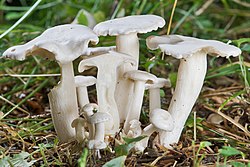| Leucocybe | |
|---|---|
 | |
| Leucocybe connata | |
| Scientific classification | |
| Kingdom: | |
| Division: | |
| Class: | |
| Order: | |
| Family: | Tricholomataceae sensu lato |
| Genus: | Leucocybe Vizzini, P.Alvarado, G.Moreno, & Consiglio (2015) |
| Type species | |
| Leucocybe candicans (Pers.) Vizzini, P.Alvarado, G.Moreno, & Consiglio (2015) | |
Leucocybe is a recently defined mushroom genus in the family Tricholomataceae (in the broad sense). The species resemble Clitocybe and grow in forests or disturbed areas. [1]